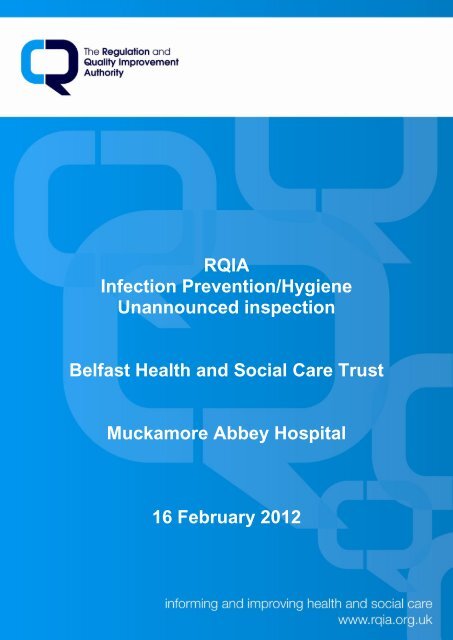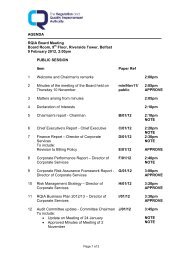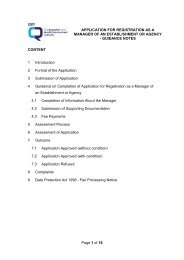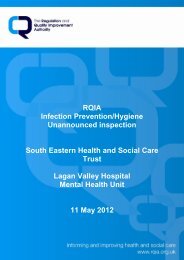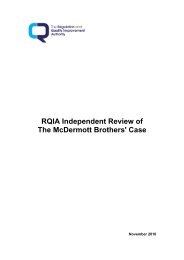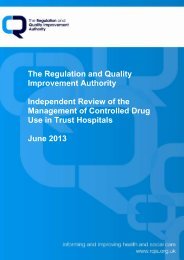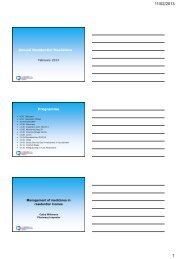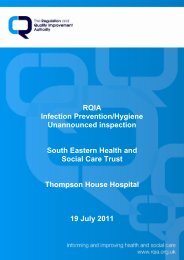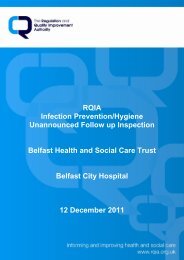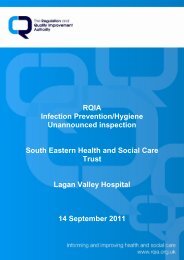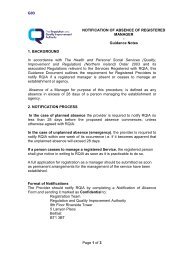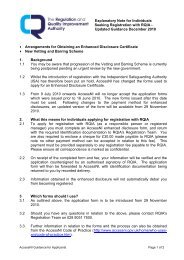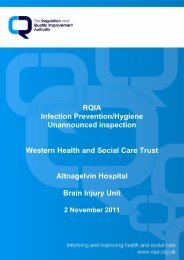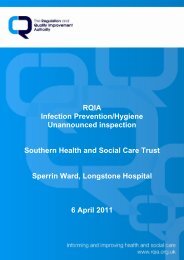Muckamore Abbey Hospital, Antrim - 16 February 2012
Muckamore Abbey Hospital, Antrim - 16 February 2012
Muckamore Abbey Hospital, Antrim - 16 February 2012
Create successful ePaper yourself
Turn your PDF publications into a flip-book with our unique Google optimized e-Paper software.
RQIA<br />
Infection Prevention/Hygiene<br />
Unannounced inspection<br />
Belfast Health and Social Care Trust<br />
<strong>Muckamore</strong> <strong>Abbey</strong> <strong>Hospital</strong><br />
<strong>16</strong> <strong>February</strong> <strong>2012</strong>
Contents<br />
1.0 Inspection Summary 1<br />
2.0 Background Information to the Inspection Process 5<br />
3.0 Inspections 6<br />
4.0 Unannounced Inspection Process 7<br />
4.1 Onsite Inspection 7<br />
4.2 Feedback and Report of the Findings 7<br />
5.0 Audit Tool 8<br />
6.0 Environment 10<br />
6.1 Cleaning 11<br />
6.2 Clutter 12<br />
6.3 Maintenance and Repair 13<br />
6.4 Fixture and Fittings 13<br />
6.5 Information 14<br />
6.6 Additional Issues 15<br />
7.0 Patient Linen 17<br />
7.1 Management of Linen 17<br />
8.0 Waste and Sharps 19<br />
8.1 Waste 19<br />
8.2 Sharps 19<br />
9.0 Patient Equipment 21<br />
10.0 Hygiene Factors 23<br />
11.0 Hygiene Practice 26<br />
11.1 Additional Issues 28<br />
12.0 Key Personnel and Information 29<br />
13.0 Summary of Recommendations 30<br />
14.0 Unannounced Inspection Flowchart 32<br />
15.0 RQIA Hygiene Team Escalation Policy Flowchart 33<br />
<strong>16</strong>.0 Action Plan 34
1.0 Inspection Summary<br />
An unannounced inspection was undertaken to <strong>Muckamore</strong> <strong>Abbey</strong><br />
<strong>Hospital</strong>, on the <strong>16</strong> <strong>February</strong> <strong>2012</strong>. The hospital was assessed<br />
against the Regional Healthcare Hygiene and Cleanliness standards<br />
and the following areas were inspected:<br />
Donegore Ward<br />
Erne Ward<br />
<strong>Muckamore</strong> <strong>Abbey</strong> <strong>Hospital</strong>, which is part of the Belfast Health and<br />
Social Care Trust, provides inpatient, assessment and treatment<br />
facilities for people with severe learning disabilities.<br />
Donegore Ward is a newly built, single storey, 9 bedded ward, with<br />
single room en-suite facilities. Female patients with various challenging<br />
behaviours and dependency levels are cared for in this ward.<br />
Erne Ward, is one of the remaining older 1950s style buildings on the<br />
<strong>Muckamore</strong> site, it is a single storey, 14 bedded ward, caring for fully<br />
dependant male patients with complex physical and learning disability<br />
needs.<br />
The inspectors were informed by senior staff that Erne ward is due to<br />
close in approximately 12 - 18 months.<br />
Inspection Outcomes<br />
Donegore Ward - achieved an overall compliance score for the<br />
inspection. Inspectors observed that the environment in general was<br />
clean and staff demonstrated compliance with hygiene and infection<br />
prevention and control practices.<br />
Erne Ward - an overall minimal compliance score was achieved.<br />
Overall the inspection findings in this ward are of concern and indicate<br />
that improvement is required in the majority of areas, of particular<br />
concern were the findings in relation to hygiene practices and patient<br />
equipment. Inspectors also identified issues in relation to the cleaning<br />
and maintenance of the ward.<br />
To provide an acceptable and safe environment for patients prior to<br />
closure it is recommended that the issues highlighted in the report are<br />
reviewed and addressed.<br />
As a result of the findings for Erne there was immediate escalation of<br />
these to the trust chief executive and a follow up inspection will be<br />
carried out within three months.<br />
The inspection resulted in 26 recommendations for <strong>Muckamore</strong> <strong>Abbey</strong><br />
<strong>Hospital</strong>, a full list of recommendations is listed in Section 13.<br />
1
A detailed list of preliminary findings is forwarded to Belfast Health and<br />
Social Care Trust within 14 days of the inspection to enable early<br />
action on identified areas which have achieved non complaint scores.<br />
The draft report which includes the high level recommendations in a<br />
Quality Improvement Plan is forwarded within 28 days of the inspection<br />
for agreement and factual accuracy. The draft report is agreed and a<br />
completed action plan is returned to RQIA within 14 days from the date<br />
of issue. The detailed list of preliminary findings is available from RQIA<br />
on request.<br />
The final report and Quality Improvement Plan will be available on the<br />
RQIA website. Reports and action plans will be subject to performance<br />
management by the Health and Social Care Board and the Public<br />
Health Agency.<br />
Notable Practice<br />
The inspection identified the following areas of notable practice:<br />
Good use of white boards which were wipeable and at times<br />
magnetic<br />
Domestic services had received recent update training,<br />
based on the DHSSPS new guidance on how to clean sinks<br />
Good domestic schedules and information in the domestic<br />
store detailed and included up to date information on how,<br />
when and the specific equipment and materials needed for<br />
cleaning<br />
The RQIA inspection team would like to thank the staff at <strong>Muckamore</strong><br />
<strong>Abbey</strong> <strong>Hospital</strong> for their assistance during the inspection.<br />
The following tables give an overview of compliance scores noted in<br />
areas inspected by RQIA:<br />
Table 1 summarises the overall compliance levels achieved.<br />
Tables 2-7 summarise the individual tables for sections two to seven of<br />
the audit tool as this assists organisation to target areas that require<br />
more specific attention.<br />
2
Table 1<br />
Donegore Erne<br />
Environment 92 71<br />
Patient Linen 94 77<br />
Waste 88 79<br />
Sharps 91 86<br />
Equipment 87 44<br />
Hygiene Factors 89 78<br />
Hygiene Practices 87 58<br />
Total 90 70<br />
Table 2<br />
Environment Donegore Erne<br />
Reception 92 84<br />
Corridors, stairs lift N/A 65<br />
Public toilets 98 81<br />
Ward/department -<br />
general(communal)<br />
89 68<br />
Patient bed area N/A 91<br />
Bathroom/washroom 84 60<br />
Toilet 97 67<br />
Clinical room/treatment<br />
room<br />
95 81<br />
Clean utility room N/A N/A<br />
Dirty utility room(Disposal<br />
store)<br />
97 N/A<br />
Domestic store 97 63<br />
Kitchen(Servery) 96 87<br />
Equipment store N/A 67<br />
Isolation 96 76<br />
General information 68 39<br />
Total 92 71<br />
Table 3<br />
Linen Donegore Erne<br />
Storage of clean linen 96 61<br />
Storage of used linen 100 93<br />
Laundry facilities 87 N/A<br />
Total 94 77<br />
Compliant:<br />
85% or above<br />
Partial Compliance: 76% to 84%<br />
Minimal Compliance: 75% or below<br />
3
Table 4<br />
Waste and sharps Donegore Erne<br />
Handling, segregation,<br />
storage, waste<br />
Availability, use, storage of<br />
sharps<br />
88 79<br />
91 86<br />
Table 5<br />
Patient Equipment Donegore Erne<br />
Patient equipment 87 44<br />
Table 6<br />
Hygiene Factors Donegore Erne<br />
Availability and cleanliness<br />
of WHB and consumables<br />
96 79<br />
Availability of alcohol rub 77 80<br />
Availability of PPE 83 67<br />
Materials and equipment<br />
for cleaning<br />
98 85<br />
Total 89 78<br />
Table 7<br />
Hygiene practices Donegore Erne<br />
Effective hand hygiene<br />
procedures<br />
80 43<br />
Safe handling and disposal<br />
of sharps<br />
100 50<br />
Effective use of PPE 100 73<br />
Correct use of isolation N/A N/A<br />
Effective cleaning of ward 63 56<br />
Staff uniform and work<br />
wear<br />
93 70<br />
Total 87 58<br />
Compliant:<br />
85% or above<br />
Partial Compliance: 76% to 84%<br />
Minimal Compliance: 75% or below<br />
4
2.0 Background Information to the Inspection Process<br />
RQIA’s infection prevention and hygiene team was established to<br />
undertake a rolling programme of unannounced inspections of acute<br />
hospitals. The Department of Health Social Service and Public Safety<br />
(DHSSPS) commitment to a programme of hygiene inspections was<br />
reaffirmed through the launch in 2010 of the revised and updated<br />
version of 'Changing the Culture' the strategic regional action plan for<br />
the prevention and control of healthcare-associated infections (HCAIs)<br />
in Northern Ireland.<br />
The aims of the inspection process are:<br />
to provide public assurance and to promote public trust and<br />
confidence<br />
to contribute to the prevention and control of HCAI<br />
to contribute to improvement in hygiene, cleanliness and infection<br />
prevention and control across health and social care in Northern<br />
Ireland<br />
In keeping with the aims of the RQIA, the team will adopt an open and<br />
transparent method for inspection, using standardised processes and<br />
documentation.<br />
5
3.0 Inspections<br />
The DHSSPS has devised Regional Healthcare Hygiene and<br />
Cleanliness standards. RQIA has revised its inspection processes to<br />
support the publication of the standards which were compiled by a<br />
regional steering group in consultation with service providers.<br />
RQIA's infection prevention/hygiene team have planned a three year<br />
programme which includes announced and unannounced inspections<br />
in acute and non-acute hospitals in Northern Ireland. This will assess<br />
compliance with the DHSSPS Regional Healthcare Hygiene and<br />
Cleanliness standards.<br />
The inspections will be undertaken in accordance with the four core<br />
activities outlined in the RQIA Corporate Strategy, these include:<br />
Improving care: we encourage and promote improvements in the<br />
safety and quality of services through the regulation and review of<br />
health and social care<br />
Informing the population: we publicly report on the safety,<br />
quality and availability of health and social care<br />
Safeguarding rights: we act to protect the rights of all people<br />
using health and social care services<br />
Influencing policy: we influence policy and standards in health<br />
and social care<br />
6
4.0 Unannounced Inspection Process<br />
Trusts receive no advanced notice of the onsite inspection. An email<br />
and telephone call will be made by the Chief Executive of RQIA or<br />
nominated person 30 minutes prior to the team arriving on site. The<br />
inspection flow chart is attached in Section 14.<br />
4.1 Onsite Inspection<br />
The inspection team was made up of four inspectors, three from<br />
RQIA’s infection prevention/hygiene team and one from RQIA’s review<br />
directorate. One inspector led the team and was responsible for<br />
guiding the team and ensuring they were in agreement about the<br />
findings reached. Membership of the inspection team is outlined in<br />
Section 12.<br />
The inspection of ward environments is carried out using the Regional<br />
Healthcare Hygiene and Cleanliness audit tool. The inspection<br />
process involves observation, discussion with staff, and review of some<br />
ward documentation.<br />
4.2 Feedback and Report of the Findings<br />
The process concludes with a feedback of key findings to trust<br />
representatives including examples of notable practice identified during<br />
the inspection. The details of trust representatives attending the<br />
feedback session is outlined in Section 12.<br />
The findings, report and follow up action will be in accordance with the<br />
Infection Prevention/Hygiene Inspection Process (methodology, follow<br />
up and reporting).<br />
The infection prevention/hygiene team escalation process will be<br />
followed if inspectors/reviewers identify any serious concerns during<br />
the inspection (Section 15).<br />
A number of documents have been developed to support and explain<br />
the inspection process. This information is currently available on<br />
request and will be available in due course on the RQIA website.<br />
7
5.0 Audit Tool<br />
The audit tool used for the inspection is based on the Regional<br />
Healthcare Hygiene and Cleanliness standards. The standards<br />
incorporate the critical areas which were identified through a review of<br />
existing standards, guidance and audit tools (Appendix 2 of Regional<br />
Healthcare Hygiene and Cleanliness standards). The audit tool follows<br />
the format of the Regional Healthcare Hygiene and Cleanliness<br />
Standards and comprises of the following sections.<br />
1. Organisational Systems and Governance: policies and<br />
procedures in relation to key hygiene and cleanliness issues;<br />
communication of policies and procedures; roles and<br />
responsibilities for hygiene and cleanliness issues; internal<br />
monitoring arrangements; arrangements to address issues<br />
identified during internal monitoring; communication of internal<br />
monitoring results to staff.<br />
This standard is not audited when carrying out unannounced<br />
inspections however the findings of the organisational<br />
system and governance at annual announced inspection will<br />
be, where applicable, confirmed at ward level.<br />
2. General Environment: cleanliness and state of repair of public<br />
areas; cleanliness and state of repair of ward/department<br />
infrastructure; cleanliness and state of repair of patient bed area;<br />
cleanliness and state of repair of toilets, bathrooms and<br />
washrooms; cleanliness and state of repair of ward/department<br />
facilities; availability and cleanliness of isolation facilities;<br />
provision of information for staff, patients and visitors<br />
3. Patient Linen: storage of clean linen; handling and storage of<br />
used linen; ward/department laundry facilities<br />
4. Waste and Sharps: waste handling; availability and storage of<br />
sharps containers<br />
5. Patient Equipment: cleanliness and state of repair of general<br />
patient equipment<br />
6. Hygiene Factors: hand wash facilities; alcohol hand rub;<br />
availability of personal protective equipment (PPE); availability of<br />
cleaning equipment and materials.<br />
7. Hygiene Practices: hand hygiene procedures; handling and<br />
disposal of sharps; use of PPE; use of isolation facilities and<br />
implementation of infection control procedures; cleaning of<br />
ward/department; staff uniform and work wear<br />
8
Level of Compliance<br />
Percentage scores can be allocated a level of compliance using the<br />
compliance categories below. The categories are allocated as follows:<br />
Compliant<br />
85% or above<br />
Partial compliance 76 to 84%<br />
Minimal compliance 75% or below<br />
Each section within the audit tool will receive an individual and an<br />
overall score, to identify areas of partial or minimal compliance to<br />
ensure that the appropriate action is taken.<br />
9
6.0 Environment<br />
STANDARD 2.0<br />
GENERAL ENVIRONMENT<br />
Cleanliness and state of repair of public areas; cleanliness and<br />
state of repair of ward/department infrastructure; cleanliness and<br />
state of repair of patient bed area; cleanliness and state of repair<br />
of toilets, bathrooms and washrooms; cleanliness and state of<br />
repair of ward/department facilities; availability and cleanliness of<br />
isolation facilities; provision of information for staff, patients and<br />
visitors.<br />
Environment Donegore Erne<br />
Reception 92 84<br />
Corridors, stairs lift N/A 65<br />
Public toilets 98 81<br />
Ward/department -<br />
general(communal)<br />
89 68<br />
Patient bed area N/A 91<br />
Bathroom/washroom 84 60<br />
Toilet 97 67<br />
Clinical room/treatment<br />
room<br />
95 81<br />
Clean utility room N/A N/A<br />
Dirty utility room(Disposal<br />
store)<br />
97 N/A<br />
Domestic store 97 63<br />
Kitchen(Servery) 96 87<br />
Equipment store N/A 67<br />
Isolation 96 76<br />
General information 68 39<br />
Total 92 71<br />
The above table outlines the findings in relation to the general<br />
environment of the facilities inspected. The findings indicate that there<br />
are concerns regarding Erne ward and in particular the minimally<br />
compliant areas highlighted in red which require immediate attention.<br />
The findings in respect of the general environment are detailed in the<br />
following sections.<br />
Inspectors note that there is a large variation in the age of the two<br />
wards inspected and the facilities available at ward level. Donegore, a<br />
new modern spacious build, has up to date fixtures, fittings and décor<br />
throughout the ward including sanitary and communal areas, with<br />
single en-suite bedrooms. Erne, an old 1950s style building, requires<br />
redecoration, maintenance and repair throughout. Personal care is<br />
10
delivered in communal sanitary areas and bedrooms are single or multi<br />
bedded rooms.<br />
6.1 Cleaning<br />
At the time of the inspection there was some evidence to indicate<br />
compliance with regional specifications for cleaning. The inspectors<br />
observed that regular cleaning mechanisms were in place however<br />
these were not always implemented or monitored. Cleaning<br />
mechanisms prevent the build-up of dust and debris, which in turn<br />
prevents the build-up of bacteria and subsequently reduces the<br />
potential risk for the transmission of infection.<br />
In Donegore, cleaning was of a satisfactory standard however greater<br />
attention to detail was required to ensure stains and smudges were<br />
removed from flooring and walls, windows and glass panelling and the<br />
kickboard in the kitchen servery.<br />
Inspectors observed that in Erne work was required to improve the<br />
standard of cleaning. Throughout the ward high and low level surfaces<br />
were dusty. Windows, windowsills, blinds, glass panelling, flooring,<br />
walls, skirting, ceiling lights and radiators required cleaning as dust soil<br />
or stains were observed.<br />
In both wards, limescale was noted on the taps of sinks in the general<br />
ward, the sinks in sanitary areas and on shower or bath fittings. In<br />
Erne greater attention was required to cleaning sinks throughout the<br />
ward. Particular care was required to ensure that limescale is removed<br />
from taps and fittings as recent evidence has shown that limescale may<br />
harbour biofilms and the build-up of limescale can interfere with good<br />
cleaning and disinfection by masking and protecting pathogens.<br />
Improvement was required in both wards when cleaning shower chairs.<br />
In Donegore the underneath of the shower chair was splashed and<br />
dirty. In Erne the top and underside of the specialist shower chair was<br />
extremely dirty. Faeces was noted on the seat, castors and the top<br />
and underside frame of the chair. Inspectors were concerned to note<br />
that this chair was used to shower patients. This was immediately<br />
brought to the attention of nursing staff who were not aware of their<br />
responsibility to clean the chair after use. Staff were unable to inform<br />
inspectors of when the chair had been last cleaned however on request<br />
from the inspectors they did clean the chair.<br />
In Erne, the underside of the dining room tables and chair crevices<br />
were dirty, and the padded sensory furniture was stained. Inspectors<br />
were concerned that staff were not fully checking patients beds as in<br />
one patient bed debris was noted under the cover, on the bed sheet.<br />
11
In Donegore the bath was dirty; the charge nurse confirmed he would<br />
contact the bath manufacturer for advice on a safe cleaning product for<br />
staff to use when cleaning the bath.<br />
In Erne bathroom and toilet, the toilet brush was faecally stained and<br />
the toilet brush holder was dusty and in the bathroom the underside of<br />
the toilet seat was stained. In the shower room there were faecal<br />
stains on the shower wall and there were a number of faecal deposits<br />
covering the shower base. In the clinical room the equipment sink<br />
drain required cleaning and the seal of the drugs fridge was dirty.<br />
The cleaning of the single bedrooms inspected in Donegore was<br />
generally good, however, attention to detail could be improved to<br />
ensure marks and stains are removed from walls and debris from<br />
between the glass window panes.<br />
In a side room in Erne, it was noted that the bedframe and underneath<br />
the mattress, were dirty, there was faecal staining on the head board<br />
and the inside of the mattress cover was stained; there was a strong<br />
smell of urine from the mattress. This is not acceptable practice as it<br />
compromises patient dignity and the delivery of care in a safe and<br />
clean environment. Although staff advised that mattress checks were<br />
carried out there were no records to substantiate this. One staff<br />
member advised that the moving and handling of a mattress to carry<br />
out a check was a health and safety/manual handling issue; staff had<br />
not been trained on how to carry out mattress checks. This issue<br />
should be reviewed by the trust manual handling and health and safety<br />
officer.<br />
In this side room, further work was required to ensure dirt is removed<br />
from the inside of the radiator and stains from the window. Inspectors<br />
noted that the hand washing sink, plughole and overflow required<br />
cleaning and there were faecal stains on the sink splash back.<br />
6.2 Clutter<br />
In both wards there was<br />
evidence of an emphasis in<br />
providing clutter free<br />
environments (Picture 1).<br />
However inspectors observed<br />
that some rooms and surfaces<br />
were cluttered in appearance.<br />
Picture 1: Donegore, Storage cupboards<br />
In Donegore the disposal<br />
room was small and untidy<br />
and in the clinical room the<br />
top surface of the<br />
venepuncture trolley was<br />
cluttered with equipment.<br />
12
Inspectors observed that in Erne a large stock of communal toiletries<br />
were in use and incontinence pads were stored out of packaging on the<br />
shelf behind the toilet; increasing the potential for aerosol<br />
contamination when flushing the toilet. The clinical room was cluttered<br />
in appearance, equipment was stored on top of cupboards, hanging<br />
basket attachments were kept in a cupboard and laundry bags were<br />
placed on top of a chair. Christmas decorations were stored in a<br />
bedroom, impeding effective cleaning.<br />
6.3 Maintenance and Repair<br />
Inspectors noted that when comparing both wards there was a marked<br />
difference in the areas where maintenance and repair was required.<br />
Donegore was generally in a good state of repair however minor wall<br />
plaster and paintwork damage was observed in the general ward and<br />
some areas of flooring, notably in the communal areas had minor rips<br />
and tears.<br />
In contrast in Erne, wall plaster and paintwork, skirting, door and door<br />
frame and floor damage was observed throughout the ward, including<br />
the single room inspected. Inspectors observed chipped dado rails,<br />
worn floor joins, exposed damaged wooden doors and door frames and<br />
missing or chipped skirting. A hole in the shower room door had been<br />
plugged with paper and the flooring around the soil pipe in the<br />
bathroom had not been sealed. A strong smell of urine was also<br />
present in the toilet.<br />
6.4 Fixtures and Fittings<br />
Inspectors observed worn, scored, damaged or torn furniture; tables,<br />
settees and chairs in both wards. It was also noted that toilet roll<br />
dispensers were not available at all toilets.<br />
In Donegore the fixtures, fittings and equipment were modern and up to<br />
date however in Erne they were old, worn and in need of replacement<br />
or repair.<br />
In Erne the public telephone was cracked and repaired with adhesive<br />
tape, a wall unit was on the floor of the visitors’ toilet and toilet seat<br />
fittings in sanitary areas were old, worn and rusted. Inspectors noted<br />
that there was a lack of toilet roll holders throughout the ward. Wooden<br />
shelving in the domestic store was unsealed, the domestic sluice sink<br />
enamel was chipped and the wooden panel worn and the tap in the<br />
patients toilet was dripping.<br />
Inspectors also observed in Erne that there were no patient privacy<br />
curtains or portable screens available in the multi bedded rooms and<br />
throughout the ward the lighting was dim, possibly hindering effective<br />
cleaning.<br />
13
In Erne the emergency pull cord in the bathroom was taped to the<br />
ceiling and therefore inaccessible in the event of an emergency.<br />
Staff advised that the bath was not used on a regular basis however<br />
were unable to advise if the water was run to prevent the development<br />
of legionella.<br />
A similar issue was noted in the single room where sink taps were old<br />
and worn. The tap twist mechanisms had been removed and the<br />
plughole sealed to prevent the flow of water. Staff were unsure if the<br />
water supply to the sink had been turned off or if there was the<br />
possibility of water pooling in the sink pipework system; therefore<br />
creating the potential for the development/spread of legionella if the tap<br />
mechanisms were reactivated.<br />
6.5 Information<br />
In both wards there were no up to date information leaflets available on<br />
hand hygiene, general infection prevention and control, MRSA and<br />
Clostridium difficile. It was also noted that there was no poster for staff<br />
on the management of an inoculation injury. In Donegore information<br />
on the segregation of waste was not available and in Erne there was no<br />
National Patient Safety Agency (NPSA) cleaning colour coded poster<br />
present for nursing staff to reference. In both wards there was good<br />
domestic schedules and information in the domestic store detailed and<br />
included up to date information on how, when and the specific<br />
equipment and materials needed for cleaning (Picture 2).<br />
Picture 2: Erne, Domestic schedules and information<br />
In Erne some posters were attached to surfaces with adhesive tape<br />
rather than blu tac and the information folder in the kitchen was<br />
damaged; the waterproof cover was split and therefore unable to be<br />
effectively cleaned.<br />
Inspectors noted that in Donegore nurse cleaning schedules while<br />
available did not detail all equipment to be cleaned. In Erne there were<br />
no nursing equipment cleaning schedules available. Schedules which<br />
detail all equipment specific to the ward and staff roles and<br />
responsibilities should be developed and displayed.<br />
14
Fridge temperature readings were recorded in both wards however in<br />
Donegore the record sheet did not evidence action taken for variations<br />
in temperature and in Erne there was no temperature range for staff to<br />
reference.<br />
6.6 Additional Issues<br />
Donegore<br />
Erne<br />
There were no toilet roll dispensers in the en-suite toilets<br />
Issues identified that compromise patient dignity and the delivery<br />
of care in a safe and clean environment have been forwarded to<br />
the RQIA Mental Health and Learning Disability Team for<br />
performance management<br />
The lighting throughout the ward was dim, possibly hindering<br />
effective cleaning<br />
Christmas decorations were stored in a bedroom, impeding<br />
effective cleaning<br />
The emergency pull cord in the bathroom was taped to the ceiling<br />
and therefore inaccessible in the event of an emergency<br />
Inspectors observed that there were no patient privacy curtains or<br />
portable screens available in the three bedded room<br />
Recommendations<br />
1. The trust should ensure that the systems and processes in<br />
place for environmental cleaning, provide the necessary<br />
assurance that cleaning is carried out effectively and that all<br />
staff are aware of their responsibilities.<br />
2. The healthcare environment should be repaired and<br />
maintained, damaged fixtures and fittings replaced to help<br />
reduce the risk of the spread of infection.<br />
3. The trust should ensure that water systems are maintained<br />
appropriately to prevent the development of legionella.<br />
4. The trust and staff should work to maintain clutter free ward<br />
environments.<br />
5. The trust should ensure all relevant information leaflets and<br />
posters are available for patients, visitors and staff to<br />
reference and use.<br />
15
6. Detailed nursing cleaning schedules should be developed.<br />
7. The trust should ensure a standard drugs fridge temperature<br />
recording sheet is developed for staff to use.<br />
8. The trust and individual staff have a collective responsibility<br />
to ensure that patients dignity is maintained at all times and<br />
care is delivered in a safe and clean environment.<br />
<strong>16</strong>
7.0 Patient Linen<br />
STANDARD 3.0<br />
PATIENT LINEN<br />
Storage of clean linen; handling and storage of used linen; ward/<br />
department laundry facilities.<br />
7.1 Management of Linen<br />
Linen Donegore Erne<br />
Storage of clean linen 96 61<br />
Storage of used linen 100 93<br />
Laundry facilities 87 N/A<br />
Total 94 77<br />
Donegore staff are commended for achieving an overall high<br />
compliance score in this standard, with full compliance achieved in the<br />
storage of used linen. In contrast Erne achieved overall partial<br />
compliance, with a minimally compliant score in the storage of clean<br />
linen.<br />
In Donegore clean linen store, the only issue identified was chipped<br />
flaky paint on the walls. In Erne the clean linen store was cluttered, the<br />
shelving was not sealed and unable to be effectively cleaned, the walls<br />
and door were stained and damaged and skirting was inaccessible to<br />
clean.<br />
Inspectors noted in Erne that although the trust has implemented sleep<br />
knit fitted sheets and bedding, flat linen and woolen blankets were<br />
stored in the clean linen store. It was also observed in the shower<br />
room that towels were stored uncovered in a wicker storage basket,<br />
behind the toilet; increasing the potential for aerosol contamination<br />
when flushing the toilet. This was also noted in Donegore, towels and<br />
a facecloth were stored uncovered on top of a storage unit beside the<br />
toilet in the bathroom. In a bedroom in Erne, washed and ironed<br />
multiple patients’ clothing, from the main laundry, was observed stored<br />
on top of a patient’s bed (Picture 2).<br />
17
Picture 2: Erne, Multiple patients clothing on a bed<br />
In both wards there were no issues identified with the handling and<br />
storage of used linen. Used linen skips were clean, however in Erne<br />
torn reusable linen bags were observed.<br />
Erne’s linen and patient clothing was processed in the main hospital<br />
laundry, Donegore had a ward based laundry. Inspectors noted in the<br />
ward laundry chipped flaky paintwork on the walls, the floor in front of<br />
the washing machine was rusted and there was limescale on the taps.<br />
It was also noted that some of the colour coded plastic containers for<br />
storing patient clothing were cracked and there was no PPE dispenser<br />
for the disposable aprons and gloves, boxes of gloves were stored on<br />
work surfaces.<br />
Recommendations<br />
9. The trust should ensure the correct handling and storage of<br />
clean linen in a designated area or in equipment which is<br />
clean and fit for purpose.<br />
18
8.0 Waste and Sharps<br />
STANDARD 4.0<br />
WASTE AND SHARPS<br />
Waste: Effectiveness of arrangements for handling, segregation,<br />
storage and disposal of waste on ward/department<br />
Sharps: Availability, use and storage of sharps containers on<br />
ward/department<br />
Waste and sharps Donegore Erne<br />
Handling, segregation,<br />
storage, waste<br />
Availability, use, storage of<br />
sharps<br />
88 79<br />
91 86<br />
8.1 Waste<br />
The inspection evidenced that there were arrangements in place for the<br />
handling, segregation, storage and disposal of waste which generally<br />
comply with local and regional guidance. Donegore achieved<br />
compliance in this standard, Erne achieved partial compliance.<br />
In both wards inspectors observed that waste was segregated and<br />
disposed of incorrectly. In Donegore household waste was disposed of<br />
into a pharmaceutical black lidded burn bin and in Erne general use<br />
sharps were observed inappropriately disposed of into a cytotoxic<br />
sharps box.<br />
In both wards it was noted that not all toilets had a household waste<br />
bin. In Donegore there was no household waste bin in a toilet and the<br />
domestic store and the household waste bin in the bathroom was<br />
starting to rust at the base. In Erne the outside of the household waste<br />
bin, in the domestic store, was stained and the base was rusty. In the<br />
bathroom the base of the household waste bin was dirty and in the<br />
shower room the lid of the household waste bin was faecally stained.<br />
Inspectors also noted a waste bag tied to the domestic trolley and<br />
nursing staff were not aware of how to dispose of suction waste.<br />
8.2 Sharps<br />
Wards are commended for achieving compliance in this standard.<br />
Sharps boxes in use conformed to BS7320 (1990)/UN9291 standards.<br />
In both wards either sharps boxes or a black lidded burn bin were not<br />
assembled correctly; labelled with the date, locality and staff signature.<br />
19
This is unsafe practice as correct labelling ensures that if there is a<br />
spillage of sharps waste from the sharps box or an injury to a staff<br />
member as a result of incorrect assembly/disposal, the area the sharps<br />
box originated from can be immediately identified. Identifying the origin<br />
of the sharps box and its contents is imperative to assist in the<br />
immediate risk assessment process carried out following a sharps<br />
injury and also to ensure that staff who incorrectly assembled/disposed<br />
of the sharps box can receive education on the correct procedures to<br />
follow. This practice was immediately addressed by the charge nurse<br />
in Donegore.<br />
Inspectors observed that sharps boxes were stored securely, tagged<br />
and signed prior to collection however in Erne the sharps boxes were<br />
dusty and staff advised that they had been waiting some time for the<br />
boxes to be collected. In both wards integral sharps trays, used to<br />
store a sharps box and equipment when carrying out a procedure,<br />
were not available; stainless steel receivers or an enamel lidded dish<br />
were in use.<br />
It was observed in all wards that the temporary closure mechanisms, to<br />
prevent spillage and impede access, were in place when the sharps<br />
boxes were not in use.<br />
Recommendations<br />
10. The trust should monitor the implementation of its policies<br />
and procedures in respect of the management of waste and<br />
sharps to ensure that safe and appropriate practice is in<br />
place.<br />
11. The trust should ensure that waste bins and equipment used<br />
in the management of waste and sharps are clean and that<br />
waste bins are available and fit for purpose.<br />
12. The trust and individual staff have a collective responsibility<br />
to ensure that staff knowledge is kept up to date regarding<br />
the safe and the correct handling and disposal of waste and<br />
sharps.<br />
20
9.0 Patient Equipment<br />
STANDARD 5.0<br />
PATIENT EQUIPMENT<br />
Cleanliness and state of repair of general patient equipment.<br />
Patient Equipment Donegore Erne<br />
Patient equipment 87 44<br />
Donegore is commended for achieving compliance in this standard<br />
however in contrast Erne achieved minimal compliance; cleaning<br />
carried out was of an unsatisfactory standard. A concentrated effort is<br />
required by all staff in Erne to improve and maintain the standard of<br />
equipment cleaning at ward level.<br />
Issues identified in both wards for action were respiratory equipment<br />
stored out of packaging, staff not aware of the symbol for single use,<br />
replacing reusable old, worn and grubby tourniquets and cleaning the<br />
tray of the water cooler/ice machine. In Donegore one further issue to<br />
be addressed related to repairing chipped and peeling laminate on the<br />
drugs trolley.<br />
In Erne, inspectors were concerned to note that a significant amount of<br />
patient equipment inspected required cleaning and some stock<br />
equipment was out of date. In the clinical room a box of sterile single<br />
use blood venepuncture sets was out of date and a large stock of<br />
laryngeal masks were due to expire in <strong>February</strong> <strong>2012</strong>; this would<br />
indicate stock rotation was not carried out. Reusable equipment was<br />
not decontaminated between patient use or discarded if single use;<br />
scissors. Reusable stainless steel kidney dishes and trays were dirty,<br />
staff advised that these were not routinely used. The commode was<br />
stained with faeces, the seat lid was split, the underside was<br />
stained/rusty and there was no trigger tape insitu to identify that the<br />
commode had been cleaned. Dirty commode pots (Picture 4) were<br />
stacked in the corner of the shower room; a staff member advised staff<br />
that these were used as receptacles to wash patients.<br />
21
Picture 4: Erne, Dirty commode pot<br />
Stored patient equipment was dirty, worn and there was no trigger tape<br />
insitu, the patient wash bowl had label residue present and was not<br />
stored inverted when not in use. The inside of the portable nebuliser<br />
machine had debris present, reusable suction canisters were<br />
dusty/dirty and the portable suction machine was dusty. The reusable<br />
single patient use nebuliser mask and chamber on the portable<br />
nebuliser machine was dirty and stored uncovered; staff had not<br />
changed or cleaned the mask after use.<br />
The underside of the drugs trolley was stained, the linen trolley was<br />
cluttered and the frame was worn. The hoist frame was dusty, stained,<br />
the frame was worn to the metal and not all staff were able to advise<br />
inspectors how to clean reusable hoist slings. Debris was noted in the<br />
wheelchair crevices, the standing aid in the bathroom was stained and<br />
dusty and the seat of the weighing scales was stained. It was also<br />
observed that due to the position of the portable resuscitation bag<br />
bedside the hand washing sink the bag was splashed with water.<br />
Recommendations<br />
13. The trust and individual staff have a collective responsibility<br />
to ensure that patient equipment is clean, stored correctly, in<br />
a good state of repair and changed in line with manufactures<br />
guidelines.<br />
14. The trust and individual staff have a collective responsibility<br />
to ensure that staff knowledge is kept up to date regarding<br />
equipment cleaning.<br />
22
10.0 Hygiene Factors<br />
STANDARD 6.0<br />
HYGIENE FACTORS<br />
Hand wash facilities; alcohol hand rub; availability of PPE;<br />
availability of cleaning equipment and materials.<br />
Hygiene Factors Donegore Erne<br />
Availability and cleanliness<br />
of WHB and consumables<br />
96 79<br />
Availability of alcohol rub 77 80<br />
Availability of PPE 83 67<br />
Materials and equipment<br />
for cleaning<br />
98 85<br />
Total 89 78<br />
Donegore achieved an overall compliance score in this standard. Erne<br />
achieved overall partial compliance, with a minimal compliance score in<br />
the availability of PPE.<br />
In Erne greater attention to detail was required to ensure hand washing<br />
sinks and fixtures and fittings were clean, accessible, working and in a<br />
good state of repair. Access to the hand washing sink in the clinical<br />
room was blocked with equipment, in the bathroom the sink overflow<br />
was dirty, in the toilet the sink was worn and stained. The hand<br />
washing sink in the visitors’ toilet was not draining; there was pooled<br />
water present and the cold water tap was dripping. In Donegore the<br />
clinical hand washing sink in the toilet had an overflow present.<br />
In general the underside of soap and hand towels dispensers was<br />
clean however care should be taken to ensure the underside of all<br />
dispensers are cleaned regularly. In Erne inspectors noted that there<br />
was no consistent approach to the placement of wall mounted soap<br />
and hand towel dispensers. In toilet areas there was either a soap<br />
dispenser and no hand towels or hand towels and no soap dispenser,<br />
therefore neither patients or staff were able to carry out effective hand<br />
hygiene.<br />
During the inspection, inspectors requested that liquid soap should be<br />
made available immediately at the sink in the shower room. A staff<br />
member advised that soap had been present at the sink however the<br />
container had become empty and had been thrown out, the staff<br />
member placed a portable pump soap dispenser at the sink. It was<br />
concerning to note that during the inspection, although numerous staff<br />
used this room for the delivery of patient care they did not appear to<br />
observe the lack of soap for hand washing purposes.<br />
23
In both wards, wall mounted alcohol rub dispensers were not available<br />
at the entrance or throughout the ward, however in Donegore a<br />
dispenser was available in the front lobby and in Erne’s clinical room.<br />
In Erne individual staff use portable alcohol rub dispensers and<br />
individual staff bottles of alcohol rub were not in use; staff advised that<br />
there were available if requested.<br />
Inspectors observed a range of PPE available however in both wards<br />
there was no consistent approach to the storage of PPE. Disposable<br />
single use aprons and gloves were either stored in cupboards or on<br />
wall mounted holders beside toilets; increasing the potential risk of<br />
aerosol contamination. In Erne sterile gloves were stored on a shelf<br />
above the toilet in the shower room, there was no face protection<br />
available for general use and overshoes were available for use when<br />
showering patients. The use of overshoes should be reviewed as<br />
these can split easily and have the potential to cause airborne<br />
dispersal when removed due to the elastic trim expanding and<br />
contracting sharply.<br />
In Donegore not all nursing staff were aware of the dilution rate for the<br />
cleaning agent in use. In Erne cleaning solutions were not stored in<br />
accordance with Control of Substances Hazardous to Health (COSHH)<br />
regulations in a locked area; the back kitchen door was open. Open<br />
tubs of detergent cleaning wipes had dried out; this would indicate they<br />
were not used regularly.<br />
In Erne attention to detail was required in the cleaning and storage of<br />
equipment used for general cleaning. Inspectors noted that some mop<br />
buckets and dust pans required cleaning and not all mop buckets and<br />
basins were stored inverted. Some inverted buckets had not been<br />
dried out effectively resulting in pools of water on the shelving. Two<br />
old, cluttered, stained and worn domestic trolleys were observed.<br />
Inspectors noted and were advised that a new domestic trolley had<br />
been delivered to the ward on the day before the inspection (Picture 5).<br />
Picture 5: Erne, New domestic trolley<br />
24
Recommendations<br />
15. The trust should ensure that hand washing sinks are clean,<br />
working and in a good state of repair.<br />
<strong>16</strong>. The trust should review and take a consistent approach to<br />
the placement of soap, hand towels and alcohol rub<br />
dispensers.<br />
17. The trust and individual staff have a collective responsibility<br />
to ensure that wall mounted dispensers are clean and that<br />
consumables are available for use.<br />
18. The trust and individual staff have a collective responsibility<br />
to ensure that PPE is stored appropriately.<br />
19. The trust should ensure that all cleaning products are stored<br />
in a locked cupboard, in line with COSHH regulations.<br />
20. The trust and individual staff have a collective responsibility<br />
to ensure that staff knowledge is kept up to date in the use of<br />
general cleaning products.<br />
21. Further attention to detail is required to ensure that<br />
equipment used for the general cleaning purposes of a ward<br />
is clean, fit for purpose and stored appropriately.<br />
25
11.0 Hygiene Practices<br />
STANDARD 7.0<br />
HYGIENE PRACTICES<br />
Hand hygiene procedures; handling and disposal of sharps; use<br />
of PPE; use of isolation facilities and implementation of infection<br />
control procedures; cleaning of ward/department; staff uniform<br />
and work wear.<br />
Hygiene practices Donegore Erne<br />
Effective hand hygiene<br />
procedures<br />
80 43<br />
Safe handling and disposal<br />
of sharps<br />
100 50<br />
Effective use of PPE 100 73<br />
Correct use of isolation N/A N/A<br />
Effective cleaning of ward 63 56<br />
Staff uniform and work<br />
wear<br />
93 70<br />
Total 87 58<br />
Donegore is commended for achieving overall compliance in this<br />
standard and full compliance in the safe handling and disposal of<br />
sharps and effective use of PPE. In contrast inspectors were<br />
concerned to note that Erne achieved minimal compliance in all<br />
sections of this standard. A concentrated effort, supported by senior<br />
management, is required in Erne to improve and maintain practices<br />
within this standard.<br />
In both wards not all nursing and care staff were aware of the 7 step<br />
hand hygiene technique for use with soap or alcohol rub. In Erne<br />
inspectors observed that hand hygiene was not carried out<br />
appropriately during personal care or when socially working with<br />
patients. Not all nursing and care staff were aware of when to<br />
appropriately use antibacterial hand washing solution; one staff<br />
member routinely used hibiscrub hand disinfectant after hand washing<br />
with soap and water. On observation inspectors noted that due to the<br />
lack of consumables there was limited opportunity for staff to carry out<br />
hand hygiene on patients. Hand hygiene audits were not carried out at<br />
ward level.<br />
There were no issues identified in Donegore with the safe handling and<br />
disposal of sharps and effective use of PPE.<br />
26
Picture 6: Erne, Venepuncture set<br />
with blood insitu<br />
In Erne a sharp was not<br />
disposed of safely into a<br />
sharps box at the point of use;<br />
a butterfly venepuncture set,<br />
with blood in the tubing, was<br />
observed in an old enamel<br />
tray stored in a cupboard<br />
(Picture 6). It was also noted<br />
on questioning of staff that not<br />
all staff were aware of the<br />
correct steps and<br />
management of an inoculation<br />
injury.<br />
Inspectors in Erne observed that sterile gloves were inappropriately<br />
used for toileting patients and delivering personal care. Face<br />
protection was not used by nursing and care staff when there was a<br />
risk of aerosol contamination from cleaning a shower chair, which was<br />
heavily soiled with faeces, and domestic staff were inappropriately<br />
using vinyl gloves when cleaning. As already mentioned in the<br />
environment section there was a lack of toilet roll holders throughout<br />
the ward. Staff advised that toilet roll is not routinely used on patient;<br />
communal tena wash cream is used to cleanse patients after toileting.<br />
It is advised that the practice is reviewed in regards to tena wash<br />
cream being a non rinse cleanser and toilet roll should be considered<br />
when removing heavy soiling.<br />
In both wards inspectors did not see routine cleaning of equipment<br />
between use, nursing staff on Erne were unfamiliar with their<br />
responsibility for cleaning. Discussion with staff identified that not all<br />
nursing and care staff were aware of the correct disinfectant solution to<br />
use or its dilution rate for general disinfectant cleaning or for cleaning<br />
blood and body fluid spillages. It was also noted that not all nursing<br />
and care staff were aware of the procedure to follow when cleaning<br />
blood and body fluid spillages. The majority of nursing and care staff<br />
were not aware of the NPSA domestic cleaning colour coded system.<br />
In both wards work is required to ensure adherence to the trust and<br />
regional dress code policy and the concept of ‘bare below the elbow’.<br />
In Donegore a member of nursing staff did not have long hair tied up<br />
off the collar and a domestic wore stoned earrings. In Erne one care<br />
staff was wearing a hoodie and another was wearing a long sleeved<br />
shirt. A nurse’s uniform was stained around the pocket, one member<br />
of staff was wearing a watch and two members of care staff were<br />
wearing nail polish. There were no changing facilities for nursing or<br />
domestic staff to change out of their uniform and care staff were<br />
unfamiliar with the trust’s uniform laundry policy.<br />
27
11.1 Additional Issues<br />
Donegore<br />
Erne<br />
Hand hygiene audits were not carried out<br />
Staff advised that toilet roll is not routinely used on patient;<br />
communal tena wash cream is used to cleanse patients after<br />
toileting. It is advised that the practice is reviewed in regards to<br />
tena wash cream being a non rinse cleanser and toilet roll should<br />
be considered when removing heavy soiling<br />
Recommendations<br />
22. The trust and individual staff have a collective responsibility to<br />
ensure that hand hygiene is carried out in line with WHO guidance<br />
and that all PPE is used appropriately.<br />
23. The trust and individual staff have a collective responsibility to<br />
ensure safe practice is carried out when handling sharps.<br />
24. The trust and individual staff have a collective responsibility to<br />
ensure that staff knowledge is kept up to date with regard to<br />
cleaning and decontamination of equipment and the environment.<br />
25. The trust should ensure that all members of staff are familiar with<br />
and adhere to the regional dress code policy.<br />
26. The trust and individual staff have a collective responsibility to<br />
ensure that personal care is delivered appropriately, using the<br />
correct equipment and solutions.<br />
28
12.0 Key Personnel and Information<br />
Members of the RQIA inspection team<br />
Mrs S O'Connor - Inspector Infection Prevention/Hygiene Team<br />
Mrs M Keating - Inspector Infection Prevention/Hygiene Team<br />
Mrs L Gawley - Inspector Infection Prevention/Hygiene Team<br />
Mrs Helen Hamilton - Project Manager, Review Directorate<br />
Trust representatives attending the feedback session<br />
Mr Barry Mills<br />
Mr Ramond Davey<br />
Mr Darren Hamill<br />
Mrs Mary Hanrahan<br />
Ms Helen Burke<br />
Mr Michael McBride<br />
- Operations Manager, Nursing<br />
- Support services Manager<br />
- Estates Service Manager<br />
- Senior Infection Prevention and Control Nurse<br />
- Ward Manager, Erne<br />
- Ward Manager, Donegore<br />
Supporting documentation<br />
A number of documents have been developed to support the inspection<br />
process, these are:<br />
Infection Prevention/Hygiene Inspection Process (methodology,<br />
follow up and reporting)<br />
Infection Prevention/Hygiene Team Inspection Protocol (this<br />
document contains details on how inspections are carried out and<br />
the composition of the teams)<br />
Infection Prevention/Hygiene Team Escalation Policy<br />
RQIA Policy and Procedure for Use and Storage of Digital Images<br />
This information is currently available on request and will be available<br />
in due course on the RQIA website.<br />
29
13.0 Summary of Recommendations<br />
1. The trust should ensure that the systems and processes in<br />
place for environmental cleaning, provide the necessary<br />
assurance that cleaning is carried out effectively and that all<br />
staff are aware of their responsibilities.<br />
2. The healthcare environment should be repaired and<br />
maintained, damaged fixtures and fittings replaced to help<br />
reduce the risk of the spread of infection.<br />
3. The trust should ensure that water systems are maintained<br />
appropriately to prevent the development of legionella.<br />
4. The trust and staff should work to maintain clutter free ward<br />
environments.<br />
5. The trust should ensure all relevant information leaflets and<br />
posters are available for patients, visitors and staff to<br />
reference and use.<br />
6. Detailed nursing cleaning schedules should be developed.<br />
7. The trust should ensure a standard drugs fridge temperature<br />
recording sheet is developed for staff to use.<br />
8. The trust and individual staff have a collective responsibility<br />
to ensure that patients dignity is maintained at all times and<br />
care is delivered in a safe and clean environment.<br />
9. The trust should ensure the correct handling and storage of<br />
clean linen in a designated area or in equipment which is<br />
clean and fit for purpose.<br />
10. The trust should monitor the implementation of its policies<br />
and procedures in respect of the management of waste and<br />
sharps to ensure that safe and appropriate practice is in<br />
place.<br />
11. The trust should ensure that waste bins and equipment used<br />
in the management of waste and sharps are clean and that<br />
waste bins are available and fit for purpose.<br />
12. The trust and individual staff have a collective responsibility<br />
to ensure that staff knowledge is kept up to date regarding<br />
the safe and the correct handling and disposal of waste and<br />
sharps.<br />
13. The trust and individual staff have a collective responsibility<br />
to ensure that patient equipment is clean, stored correctly, in<br />
30
a good state of repair and changed in line with manufactures<br />
guidelines.<br />
14. The trust and individual staff have a collective responsibility<br />
to ensure that staff knowledge is kept up to date regarding<br />
equipment cleaning.<br />
15. The trust should ensure that hand washing sinks are clean,<br />
working and in a good state of repair.<br />
<strong>16</strong>. The trust should review and take a consistent approach to<br />
the placement of soap, hand towels and alcohol rub<br />
dispensers.<br />
17. The trust and individual staff have a collective responsibility<br />
to ensure that wall mounted dispensers are clean and that<br />
consumables are available for use.<br />
18. The trust and individual staff have a collective responsibility<br />
to ensure that PPE is stored appropriately.<br />
19. The trust should ensure that all cleaning products are stored<br />
in a locked cupboard, in line with COSHH regulations.<br />
20. The trust and individual staff have a collective responsibility<br />
to ensure that staff knowledge is kept up to date in the use of<br />
general cleaning products.<br />
21. Further attention to detail is required to ensure that<br />
equipment used for the general cleaning purposes of a ward<br />
is clean, fit for purpose and stored appropriately.<br />
22. The trust and individual staff have a collective responsibility<br />
to ensure that hand hygiene is carried out in line with WHO<br />
guidance and that all PPE is used appropriately.<br />
23. The trust and individual staff have a collective responsibility<br />
to ensure safe practice is carried out when handling sharps.<br />
24. The trust and individual staff have a collective responsibility<br />
to ensure that staff knowledge is kept up to date with regard<br />
to cleaning and decontamination of equipment and the<br />
environment.<br />
25. The trust should ensure that all members of staff are familiar<br />
with and adhere to the regional dress code policy.<br />
26. The trust and individual staff have a collective responsibility<br />
to ensure that personal care is delivered appropriately, using<br />
the correct equipment and solutions.<br />
31
Reporting & Re-Audit<br />
Episode of Inspection<br />
Plan Programme<br />
14.0 Unannounced Inspection Flowchart<br />
Environmental Scan:<br />
Stakeholders & External<br />
Information<br />
Plan<br />
Programme<br />
Consider:<br />
Areas of Non-Compliance<br />
Infection Rates<br />
Trust Information<br />
RQIA Hygiene Team<br />
Prioritise Themes & Areas for Core Inspections<br />
Prior to Inspection Year<br />
Balance Programme<br />
January/<strong>February</strong><br />
Schedule Inspections<br />
Prior to Inspection<br />
Identify & Prepare Inspection Team<br />
Day of Inspection<br />
Inform Trust<br />
Day of Inspection<br />
Carry out Inspection<br />
A<br />
Is there immediate risk<br />
requiring formal escalation?<br />
NO<br />
YES<br />
Invoke<br />
RQIA<br />
IPHTeam<br />
Escalation<br />
Process<br />
Day of Inspection<br />
Feedback Session with Trust<br />
14 days after<br />
Inspection<br />
28 days after<br />
Inspection<br />
Preliminary Findings<br />
disseminated to Trust<br />
Draft Report<br />
disseminated to Trust<br />
NO<br />
Does assessment of<br />
the findings require<br />
escalation?<br />
YES<br />
Invoke<br />
RQIA<br />
IPHTeam<br />
Escalation<br />
Process<br />
A<br />
14 days later<br />
Signed Action Plan<br />
received from Trust<br />
Within 0-3 months<br />
Is a Follow-Up required?<br />
Based on Risk Assessment/key<br />
indicators or Unsatisfactory Quality<br />
Improvement Plan (QIP)?<br />
YES<br />
Invoke<br />
Follow-Up<br />
Protocol<br />
Process enables<br />
only 1 Follow-Up<br />
NO<br />
Open Report published to Website<br />
YES<br />
Is Follow-Up<br />
satisfactory?<br />
NO<br />
DHSSPS/HSC<br />
Board/PHA<br />
PHA<br />
32
15.0 Escalation Process<br />
RQIA Hygiene Team: Escalation Process<br />
B<br />
RQIA IPH<br />
Team<br />
Escalation<br />
Process<br />
Concern / Allegation / Disclosure<br />
Inform Team Leader / Head of Programme<br />
MINOR/MODERATE<br />
Has the risk been<br />
assessed as Minor,<br />
Moderate or Major?<br />
MAJOR<br />
Inform key contact and keep a record<br />
Inform appropriate RQIA Director and Chief Executive<br />
Record in final report<br />
Inform Trust / Establishment / Agency<br />
and request action plan<br />
Notify Chairperson and<br />
Board Members<br />
Inform other establishments as appropriate:<br />
E.g.: DHSSPS, RRT, HSC Board, PHA,<br />
HSENI<br />
Seek assurance on implementation of actions<br />
Take necessary action:<br />
E.g.: Follow-Up Inspection<br />
33
<strong>16</strong>.0 Action Plan<br />
Ref No.<br />
Recommendations<br />
1. The trust should ensure that the systems and processes<br />
in place for environmental cleaning; provide the<br />
necessary assurance that cleaning is carried out<br />
effectively and that all staff are aware of their<br />
responsibilities.<br />
Designated<br />
department<br />
Nursing<br />
PCSS<br />
IPC<br />
Action required<br />
‘Roles and responsibilities of Staff in<br />
relation to Environmental Cleanliness and<br />
Cleanliness of Equipment’ policy under<br />
review.<br />
Work / negotiations in relation to the<br />
cleaning manual are still ongoing. In<br />
particular, there is discussion with<br />
nursing/control of infection with reference<br />
to bed cleaning. Once agreement is<br />
reached the manual will be finalised.<br />
Date for<br />
completion/<br />
timescale<br />
Mar <strong>2012</strong><br />
Jun <strong>2012</strong><br />
2. The healthcare environment should be repaired and<br />
maintained, damaged fixtures and fittings replaced to<br />
help reduce the risk of the spread of infection.<br />
3. The trust should ensure that water systems are<br />
maintained appropriately to prevent the development of<br />
legionella.<br />
4. The trust and staff should work to maintain clutter free<br />
ward environments.<br />
5. The trust should ensure all relevant information leaflets<br />
and posters are available for patients, visitors and staff to<br />
reference and use.<br />
Estates<br />
IPC<br />
Other<br />
appropriate<br />
staff<br />
Estates<br />
All<br />
Directorates<br />
IPC<br />
All of these aspects will be monitored<br />
through the programme of Environmental<br />
Cleanliness Audits based on the<br />
Cleanliness Matters Strategy and results<br />
fed back through Balanced Scorecards.<br />
This is ongoing as part of Estate daily<br />
maintenance and refurbishment<br />
programmes.<br />
Water systems are managed under the<br />
auspices of the Water Safety & Usage<br />
Group and the Trust’s Water Management<br />
Plan.<br />
Planned programme of de-clutter and<br />
deep cleaning in place. Ongoing space<br />
utilisation and de-cluttering is being driven<br />
by Service Managers.<br />
The Trust has secured funding from the<br />
PHA to take forward the issue of HCAI<br />
communication.<br />
Ongoing<br />
Ongoing<br />
Ongoing<br />
Ongoing<br />
Jun <strong>2012</strong><br />
6. Detailed nursing cleaning schedules should be Nursing A sub-group of IPECC (Infection Complete<br />
34
Ref No.<br />
Recommendations<br />
Designated<br />
department<br />
Action required<br />
developed. IPECC Prevention & Environment and<br />
Cleanliness Committee) has been set up<br />
to review and standardise cleaning<br />
schedules, and will establish any<br />
outstanding issues of audit<br />
standardisation process.<br />
Agree a standardised audit which will be<br />
used in all areas. This will include<br />
standardised responsibilities. To be kept<br />
under review.<br />
Systematic roll out of the agreed<br />
standardised audit using the Maximiser<br />
system.<br />
Date for<br />
completion/<br />
timescale<br />
Commencing<br />
Feb <strong>2012</strong><br />
7. The trust should ensure a standard drugs fridge<br />
temperature recording sheet is developed for staff to use.<br />
Nursing<br />
The Medicines Code outlines procedures<br />
for use of medicine fridges. A<br />
pharmaceutical refrigerator temperature<br />
log sheet is maintained for each individual<br />
fridge, with records being maintained and<br />
monitored by Ward Managers.<br />
Ongoing<br />
8. The trust and individual staff have a collective<br />
responsibility to ensure that patients’ dignity is maintained<br />
at all times and care is delivered in a safe and clean<br />
environment.<br />
Nursing<br />
The Trust has a Patient Privacy and<br />
Dignity Policy. The contents of this policy<br />
and the importance of adhering to it will<br />
be re-iterated to all relevant staff.<br />
Complete<br />
9. The trust should ensure the correct handling and storage<br />
of clean linen in a designated area or in equipment which<br />
is clean and fit for purpose.<br />
Nursing<br />
Guidance regarding storage of linen is in<br />
the Regional Infection Prevention Manual.<br />
Linen storage and segregation guidance<br />
has been circulated to all Directorates.<br />
Complete<br />
This states that all linen must be stored off<br />
the floor in a clean dedicated area that<br />
allows for ease of access and rotation of<br />
stock and that Linen rooms must have<br />
shelving that are easy to clean, and<br />
35
Ref No.<br />
Recommendations<br />
Designated<br />
department<br />
Action required<br />
cleaning frequencies must be at least<br />
quarterly.<br />
Date for<br />
completion/<br />
timescale<br />
10. The trust should monitor the implementation of its policies<br />
and procedures in respect of the management of waste<br />
and sharps to ensure that safe and appropriate practice is<br />
in place.<br />
PCSS<br />
Nursing<br />
The Trust will pilot and roll out across all<br />
facilities the use of an electronic tool to<br />
audit waste management compliance<br />
against policy, procedure and RQIA<br />
requirements. This process will<br />
supplement the existing audit tools used<br />
by PCSS, IPC and also existing external<br />
audits conducted by Daniels (sharps box<br />
suppliers).<br />
Daniels’ audit completed Oct 2011 and<br />
results disseminated.<br />
Pilot<br />
completed<br />
Roll-out<br />
programme<br />
across Trust to<br />
be completed<br />
by Apr <strong>2012</strong><br />
Complete<br />
11. The trust should ensure that waste bins and equipment<br />
used in the management of waste and sharps are clean<br />
and that waste bins are available and fit for purpose.<br />
PCSS<br />
Nursing<br />
This is monitored as part of the<br />
Environmental Cleanliness Audit<br />
Programme.<br />
Ongoing<br />
Regional contract for bins at adjudication<br />
stage.<br />
Environmental cleanliness audit<br />
programmes, which include daily ward<br />
checks, department and managerial<br />
audits, and IPC audits monitor<br />
compliance.<br />
Where an issue has been highlighted,<br />
action will be taken in conjunction with the<br />
appropriate department to ensure<br />
rectification.<br />
12. The trust and individual staff have a collective<br />
responsibility to ensure that staff knowledge is kept up to<br />
date regarding the safe and the correct handling and<br />
disposal of waste and sharps.<br />
IPC<br />
There is a training programme available to<br />
all staff.<br />
Update and refresher training will continue<br />
Complete<br />
36
Ref No.<br />
Recommendations<br />
Designated<br />
department<br />
to be provided.<br />
Action required<br />
Date for<br />
completion/<br />
timescale<br />
The Trust will pilot and roll out across all<br />
facilities the use of an electronic tool to<br />
audit waste management compliance<br />
against policy, procedure and RQIA<br />
requirements. This process will<br />
supplement the existing audit tools used<br />
by PCSS, IPC and also existing external<br />
audits conducted by Daniels (sharps box<br />
suppliers).<br />
Pilot<br />
completed<br />
Roll-out<br />
programme<br />
across Trust to<br />
be completed<br />
by Apr <strong>2012</strong><br />
‘Daniels’ audit completed in October 2011<br />
and results have been disseminated<br />
Safer Needle Device Group met again in<br />
Dec 2011.<br />
13. The trust and individual staff have a collective<br />
responsibility to ensure that patient equipment is clean,<br />
stored correctly, in a good state of repair and changed in<br />
line with manufactures guidelines.<br />
Nursing<br />
PCSS<br />
Work / negotiations in relation to the<br />
cleaning manual are still ongoing. In<br />
particular, there is discussion with<br />
nursing/control of infection with reference<br />
bed cleaning. Once agreement is reached<br />
the manual will be finalised.<br />
Jun <strong>2012</strong><br />
The manual includes roles and<br />
responsibilities of trust staff in relation to<br />
patient equipment. A template will be<br />
used to record all cleaning of equipment.<br />
14. The trust and individual staff have a collective<br />
responsibility to ensure that staff knowledge is kept up to<br />
date regarding equipment cleaning.<br />
Nursing<br />
Role and responsibilities policy in place.<br />
Cleaning statements document for all<br />
wards and departments to be finalised<br />
and disseminated. This forms part of the<br />
cleaning manual.<br />
Complete<br />
Jun <strong>2012</strong><br />
37
Ref No.<br />
Recommendations<br />
15. The trust should ensure that hand washing sinks are<br />
clean, working and in a good state of repair.<br />
Designated<br />
department<br />
PCSS<br />
Action required<br />
This is monitored as part of the<br />
Environmental Cleanliness Audit<br />
Programme. Staff are reminded of the<br />
importance of replenishing dispensers.<br />
Date for<br />
completion/<br />
timescale<br />
Ongoing<br />
Environmental cleanliness audit<br />
programmes, which include daily ward<br />
checks, department and managerial<br />
audits, and IPC audits monitor<br />
compliance.<br />
Where an issue has been highlighted,<br />
action will be taken in conjunction with the<br />
appropriate department to ensure<br />
rectification.<br />
Regular training is provided to all<br />
appropriate staff.<br />
<strong>16</strong>. The trust should review and take a consistent approach<br />
to the placement of soap, hand towels and alcohol rub<br />
dispensers.<br />
PCSS<br />
Nursing<br />
As part of the departmental audit process,<br />
all sinks will be checked for soap, hand<br />
towel and alcohol rub dispensers.<br />
Complete<br />
17. The trust and individual staff have a collective<br />
responsibility to ensure that wall mounted dispensers are<br />
clean and that consumables are available for use.<br />
PCSS<br />
This is monitored as part of the<br />
Environmental Cleanliness Audit<br />
Programme. Staff are reminded of the<br />
importance of replenishing dispensers.<br />
Ongoing<br />
Environmental cleanliness audit<br />
programmes, which include daily ward<br />
checks, department and managerial<br />
audits, and IPC audits monitor<br />
compliance.<br />
Where an issue has been highlighted,<br />
action will be taken in conjunction with the<br />
appropriate department to ensure<br />
rectification.<br />
38
Ref No.<br />
Recommendations<br />
Designated<br />
department<br />
Action required<br />
Date for<br />
completion/<br />
timescale<br />
18. The trust and individual staff have a collective<br />
responsibility to ensure that PPE is stored appropriately.<br />
Nursing<br />
IPC<br />
Regular training is provided to all<br />
appropriate staff.<br />
This is monitored during IPC visits and<br />
audits.<br />
Ongoing<br />
Ward staff will monitor on an ongoing<br />
basis<br />
19. The trust should ensure that all cleaning products are<br />
stored in a locked cupboard, in line with COSHH<br />
regulations.<br />
PCSS<br />
Locked cupboards are provided.<br />
Ward managers and PCSS supervisors<br />
carry out regular checks to ensure all staff<br />
comply with COSHH procedures. Audited<br />
as part of Belfast Risk Assessment and<br />
Audit Tool (BRAAT).<br />
Complete and<br />
ongoing<br />
20. The trust and individual staff have a collective<br />
responsibility to ensure that staff knowledge is kept up to<br />
date in the use of general cleaning products.<br />
21. Further attention to detail is required to ensure that<br />
equipment used for the general cleaning purposes of a<br />
ward is clean, fit for purpose and stored appropriately.<br />
PCSS<br />
Nursing<br />
PCSS<br />
The Trust is BICS accredited and is in the<br />
process of training supervisors and<br />
assessors in BICS. Training is ongoing<br />
and includes staff knowledge in the use of<br />
cleaning materials.<br />
Environmental cleanliness audit<br />
programmes, which include daily ward<br />
checks, department and managerial<br />
audits, and IPC audits monitor<br />
compliance.<br />
Ongoing<br />
Ongoing<br />
Where an issue has been highlighted,<br />
action will be taken in conjunction with the<br />
appropriate department to ensure<br />
rectification.<br />
Regular training is provided to all<br />
appropriate staff.<br />
Work / negotiations in relation to the<br />
Jun <strong>2012</strong><br />
39
Ref No.<br />
Recommendations<br />
22. The trust and individual staff have a collective<br />
responsibility to ensure that hand hygiene is carried out in<br />
line with WHO guidance and that all PPE is used<br />
appropriately.<br />
Designated<br />
department<br />
IPCT<br />
Action required<br />
cleaning manual are still ongoing. In<br />
particular, there is discussion with<br />
nursing/control of infection with reference<br />
bed cleaning. Once agreement is reached<br />
the manual will be finalised.<br />
Balance scorecards, which include WHO<br />
Hand Hygiene audits. All of these aspects<br />
will be monitored through the programme<br />
of Environmental Cleanliness Audits<br />
based on the Cleanliness Matters<br />
Strategy.<br />
Date for<br />
completion/<br />
timescale<br />
Complete and<br />
Ongoing<br />
The IPCT carried out an independent<br />
audit and results have been fed back.<br />
Independent audits will be carried out 4<br />
times a year (2 of which will be carried out<br />
by Infection Prevention and Control).<br />
23. The trust and individual staff have a collective<br />
responsibility to ensure safe practice is carried out when<br />
handling sharps.<br />
PCSS<br />
The IPCT is currently devising an<br />
educational tool to remind staff of the<br />
appropriate use of PPE.<br />
There is a training programme available to<br />
all staff.<br />
Update and refresher training will continue<br />
to be provided.<br />
Complete<br />
The Trust will pilot and roll out across all<br />
facilities the use of an electronic tool to<br />
audit waste management compliance<br />
against policy, procedure and RQIA<br />
requirements. This process will<br />
supplement the existing audit tools used<br />
by PCSS, IPC and also existing external<br />
audits conducted by Daniels (sharps box<br />
suppliers).<br />
Pilot<br />
completed<br />
Roll-out<br />
programme<br />
across Trust to<br />
be completed<br />
by Apr <strong>2012</strong><br />
‘Daniels’ audit completed in October 2011<br />
40
Ref No.<br />
Recommendations<br />
Designated<br />
department<br />
Action required<br />
and results have been disseminated<br />
Date for<br />
completion/<br />
timescale<br />
Safer Needle Device Group met again in<br />
Dec 2011.<br />
24. The trust and individual staff have a collective<br />
responsibility to ensure that staff knowledge is kept up to<br />
date with regard to cleaning and decontamination of<br />
equipment and the environment.<br />
IPCT<br />
Mandatory Infection Prevention & Control<br />
training is delivered by IPCN Team.<br />
Staff to be reminded of the link to the<br />
regional Infection Control Manual and the<br />
‘Medical and Nursing Equipment Cleaning<br />
Guide’ has been re-circulated.<br />
Ongoing<br />
All service managers received email<br />
copies of the cleaning guide poster for<br />
dissemination to all wards and<br />
departments. Assurance is gained<br />
through environmental cleanliness audit<br />
programmes, which include daily ward<br />
checks, department and managerial<br />
audits, and IPC audits monitor<br />
compliance.<br />
Where an issue has been highlighted,<br />
action will be taken in conjunction with the<br />
appropriate department to ensure<br />
rectification.<br />
25. The trust should ensure that all members of staff are<br />
familiar with and adhere to the regional dress code policy.<br />
All<br />
Directorates<br />
Trust policy available to all staff on<br />
Intranet. Policy is enforced at local level<br />
by senior staff, e.g., Ward Sisters and<br />
Senior Managers.<br />
Complete<br />
The Ward Sister/Charge Nurse Support<br />
Improvement and Accountability<br />
Framework (SIAF) includes an indicator<br />
relating to compliance with the dress code<br />
policy and this is audited on a quarterly<br />
Ongoing<br />
41
Ref No.<br />
Recommendations<br />
Designated<br />
department<br />
basis.<br />
Action required<br />
Date for<br />
completion/<br />
timescale<br />
26. The trust and individual staff have a collective<br />
responsibility to ensure that personal care is delivered<br />
appropriately, using the correct equipment and solutions.<br />
Nursing<br />
All ward staff are now using the<br />
appropriate equipment and materials.<br />
Complete<br />
42


